A Simple Monopole Antenna with a Switchable Beam for 5G Millimeter-Wave Communication Systems
Abstract
:1. Introduction
- The presented work is a low-cost planar antenna with the functionality of reconfigurability using PIN diodes in the 5G mm-wave band;
- The proposed antenna realizes pattern reconfiguration without adding additional circuits; therefore, it is characterized by a compact size, making it a proper candidate for future 5G miniaturized smart devices and the IoT;
- The proposed antenna presents good radiation characteristics along with a high gain (up to 8 dB) and broad bandwidth to cover the complete 28 GHz band spectrum (i.e., 26–29.5 GHz), along with a beam tilting of (±18).
2. The Geometry of the Proposed Antenna
3. Design Methodology of the Proposed Antenna
3.1. Design of the Wideband Monopole Antenna
3.2. Design of the Proposed Wideband Switched-Beam Monopole Antenna
4. Simulated and Experimental Results
4.1. Reflection Coefficient
4.2. Gain and Radiation Patterns
4.3. Comparison with State-of-the-Art Works
5. Conclusions
Author Contributions
Funding
Conflicts of Interest
References
- Yang, S.; Zhang, C.; Pan, H.K.; Fathy, A.E.; Nair, V.K. Frequency-Reconfigurable Antennas for Multiradio Wireless Platforms. IEEE Microw. Mag. 2009, 10, 66–83. [Google Scholar] [CrossRef]
- Mohanta, H.C.; Kouzani, A.Z.; Mandal, S.K. Reconfigurable Antennas and Their Applications. Univers. J. Electr. Electron. Eng. 2019, 6, 239–258. [Google Scholar] [CrossRef]
- Haupt, R.L.; Lanagan, M. Reconfigurable Antennas. IEEE Antennas Propag. Mag. 2013, 55, 49–61. [Google Scholar] [CrossRef]
- Ojaroudi Parchin, N.; Jahanbakhsh Basherlou, H.; Al-Yasir, Y.I.A.; Abdulkhaleq, A.M.; Abd-Alhameed, R.A. Reconfigurable Antennas: Switching Techniques—A Survey. Electronics 2020, 9, 336. [Google Scholar] [CrossRef] [Green Version]
- Haider, N.; Caratelli, D.; Yarovoy, A.G. Recent Developments in Reconfigurable and Multiband Antenna Technology. Int. J. Antennas Propag. 2013, 869170. [Google Scholar] [CrossRef] [Green Version]
- Mahlaoui, Z.; Antonino-Daviu, E.; Ferrando-Bataller, M. Radiation Pattern Reconfigurable Antenna for IoT Devices. Int. J. Antennas Propag. 2021, 5534063. [Google Scholar] [CrossRef]
- Ojaroudi Parchin, N.; Jahanbakhsh Basherlou, H.; Al-Yasir, Y.I.A.; Abd-Alhameed, R.A.; Abdulkhaleq, A.M.; Noras, J.M. Recent Developments of Reconfigurable Antennas for Current and Future Wireless Communication Systems. Electronics 2019, 8, 128. [Google Scholar] [CrossRef] [Green Version]
- Saad, A.A.R.; Mohamed, H.A. Printed millimeter-wave MIMO-based slot antenna arrays for 5G networks. AEU—Int. J. Electron. Commun. 2019, 99, 59–69. [Google Scholar] [CrossRef]
- Shah, I.; Hayat, S.; Basir, A.; Zada, M.; Shah, S.; Ullah, S. Design and analysis of a hexa-band frequency reconfigurable antenna for wireless communication. AEU—Int. J. Electron. Commun. 2019, 98, 80–88. [Google Scholar] [CrossRef]
- Chen, X.; Zhao, Y. Dual-band polarization and frequency reconfigurable antenna using double layer metasurface. AEU—Int. J. Electron. Commun. 2018, 95, 82–87. [Google Scholar] [CrossRef]
- Naqvi, A.H.; Lim, S. Microfluidically Polarization-Switchable Metasurfaced Antenna. IEEE Antennas Wirel. Propag. Lett. 2018, 17, 2255–2259. [Google Scholar] [CrossRef]
- Hussain, N.; Jeong, M.J.; Park, J.; Kim, N. A Broadband Circularly Polarized Fabry-Perot Resonant Antenna Using A Single-Layered PRS for 5G MIMO Applications. IEEE Access 2019, 7, 42897–42907. [Google Scholar] [CrossRef]
- Hussain, N.; Park, I. Design of a wide-gain-bandwidth metasurface antenna at terahertz frequency. AIP Adv. 2017, 7, 055313. [Google Scholar] [CrossRef] [Green Version]
- Naqvi, A.H.; Lim, S. A Beam-Steering Antenna With a Fluidically Programmable Metasurface. IEEE Trans. Antennas Propag. 2019, 67, 3704–3711. [Google Scholar] [CrossRef]
- Tran, H.H.; Le, T.T. A metasurface based low-profile reconfigurable antenna with pattern diversity. AEU—Int. J. Electron. Commun. 2020, 115, 153037. [Google Scholar] [CrossRef]
- Naqvi, S.I.; Naqvi, A.H.; Arshad, F.; Riaz, M.A.; Azam, M.A.; Khan, M.S.; Amin, Y.; Loo, J.; Tenhunen, H. An Integrated Antenna System for 4G and Millimeter-Wave 5G Future Handheld Devices. IEEE Access 2019, 7, 116555–116566. [Google Scholar] [CrossRef]
- Kakhki, M.B.; Denidni, T.A. Beam Tilting Antenna Using FSS Layer for 5G Applications. In Proceedings of the 2018 IEEE International Symposium on Antennas and Propagation USNC/URSI National Radio Science Meeting, Boston, MA, USA, 8–13 July 2018; pp. 47–48. [Google Scholar] [CrossRef]
- Mantash, M.; Kesavan, A.; Denidni, T.A. Beam-Tilting Endfire Antenna Using a Single-Layer FSS for 5G Communication Networks. IEEE Antennas Wirel. Propag. Lett. 2018, 17, 29–33. [Google Scholar] [CrossRef]
- Esmail, B.A.F.; Majid, H.A.; Dahlan, S.H.; Abidin, Z.Z.; Rahim, M.K.A.; Abdullah, M.A.; Jusoh, M. Antenna beam tilting and gain enhancement using novel metamaterial structure at 28 GHz. In Proceedings of the 2018 IEEE International RF and Microwave Conference (RFM), Penang, Malaysia, 17–19 December 2018; pp. 53–56. [Google Scholar] [CrossRef]
- Awan, W.A.; Ghaffar, A.; Hussain, N.; Li, X.J. A Frequency Reconfigurable Flexible Antenna for Multiple Mobile Applications. In Proceedings of the 2019 IEEE Asia-Pacific Microwave Conference (APMC), Singapore, 10–13 December 2019; pp. 813–815. [Google Scholar] [CrossRef]
- Shakhirul, M.S.; Jusoh, M.; Lee, Y.S.; Husna, C.R.N. A Review of Reconfigurable Frequency Switching Technique on Micostrip Antenna. J. Phys. Conf. Ser. 2018, 1019, 012042. [Google Scholar] [CrossRef]
- Al Abbas, E.; Nguyen-Trong, N.; Mobashsher, A.T.; Abbosh, A.M. Polarization-Reconfigurable Antenna Array for Millimeter-Wave 5G. IEEE Access 2019, 7, 131214–131220. [Google Scholar] [CrossRef]
- Shereen, M.K.; Khattak, M.I.; Witjaksono, G. A brief review of frequency, radiation pattern, polarization, and compound reconfigurable antennas for 5G applications. J. Comput. Electron. 2019, 18, 1065–1102. [Google Scholar] [CrossRef]
- Ikram, M.; Nguyen-Trong, N.; Abbosh, A.M. Common-Aperture Sub-6 GHz and Millimeter-Wave 5G Antenna System. IEEE Access 2020, 8, 199415–199423. [Google Scholar] [CrossRef]
- Yang, X.; Xiao, J.; Wang, J.; Sheng, L. Compact Frequency Reconfigurable Antennas Based on Composite Right/Left-Handed Transmission Line. IEEE Access 2019, 7, 131663–131671. [Google Scholar] [CrossRef]
- Jilani, S.F.; Rahimian, A.; Alfadhl, Y.; Alomainy, A. Low-profile flexible frequency-reconfigurable millimetre-wave antenna for 5G applications. Flex. Print. Electron. 2018, 3, 035003. [Google Scholar] [CrossRef]
- Ali Esmail, B.; Majid, H.A.; Zainal Abidin, Z.; Haimi Dahlan, S.; Himdi, M.; Dewan, R.; Kamal A Rahim, M.; Al-Fadhali, N. Reconfigurable Radiation Pattern of Planar Antenna Using Metamaterial for 5G Applications. Materials 2020, 13, 582. [Google Scholar] [CrossRef] [Green Version]
- Esmail, B.A.F.; Majid, H.A.; Dahlan, S.H.; Zainal abidin, Z.; Himdi, M.; Dewan, R.; Rahim, M.K.A.; Ashyap, A.Y.I. Reconfigurable metamaterial structure for 5G beam tilting antenna applications. Waves Random Complex Media 2020, 1–14. [Google Scholar] [CrossRef]
- Abbas, S.M.; Esselle, K.P.; Ranga, Y.; Qin, P.Y. Reconfigurable antennas with narrowband and ultra wideband modes. In Proceedings of the 2015 IEEE MTT-S 2015 International Microwave Workshop Series on RF and Wireless Technologies for Biomedical and Healthcare Applications (IMWS-BIO), Taipei, Taiwan, 21–23 September 2015; pp. 56–57. [Google Scholar] [CrossRef]
- Jilani, S.F.; Abbas, S.M.; Esselle, K.P.; Alomainy, A. Millimeter-wave frequency reconfigurable T-shaped antenna for 5G networks. In Proceedings of the 2015 IEEE 11th International Conference on Wireless and Mobile Computing, Networking and Communications (WiMob), Abu Dhabi, United Arab Emirates, 19–21 October 2015; pp. 100–102. [Google Scholar] [CrossRef]
- Abbas, S.M.; Ranga, Y.; Esselle, K.P. A switchable printed antenna with a ground plane for 2.45/5 GHz wireless body area networks. In Proceedings of the 2015 International Workshop on Antenna Technology (iWAT), Seoul, Korea, 4–6 March 2015; pp. 27–29. [Google Scholar] [CrossRef]
- Awan, W.A.; Zaidi, A.; Hussain, N.; Iqbal, A.; Baghdad, A. Stub loaded, low profile UWB antenna with independently controllable notch-bands. Microw. Opt. Technol. Lett. 2019, 61, 2447–2454. [Google Scholar] [CrossRef]
- Balanis, C. Antenna Theory: Analysis and Design; Wiley: Hoboken, NJ, USA, 2016. [Google Scholar]
- Federal Communications Commission. FCC Establishes Procedures for First 5G Spectrum Auctions; Federal Communications Commission: Washington, DC, USA, 2018. [Google Scholar]
- Awan, W.A.; Hussain, N.; Le, T.T. Ultra-thin flexible fractal antenna for 2.45 GHz application with wideband harmonic rejection. AEU—Int. J. Electron. Commun. 2019, 110, 152851. [Google Scholar] [CrossRef]
- Naqvi, S.A. Miniaturized triple-band and ultra-wideband (UWB) fractal antennas for UWB applications. Microw. Opt. Technol. Lett. 2017, 59, 1542–1546. [Google Scholar] [CrossRef]
- JYEBAO Co. Ltd. Available online: www.jyebao.com.tw (accessed on 9 March 2020).
- MACOM. Available online: www.macom.com (accessed on 9 March 2020).
- Zahra, H.; Awan, W.A.; Hussain, N.; Abbas, S.M.; Mukhopadhyay, S. Helix Inspired 28 GHz Broadband Antenna with End-Fire Radiation Pattern. Comput. Mater. Contin. 2022, 70, 1935–1944. [Google Scholar] [CrossRef]
- Shaik, P.; Singya, P.K.; Bhatia, V. Performance analysis of QAM schemes for non-regenerative cooperative MIMO network with transmit antenna selection. AEU—Int. J. Electron. Commun. 2019, 107, 298–306. [Google Scholar] [CrossRef]
- Zahra, H.; Awan, W.A.; Ali, W.A.E.; Hussain, N.; Abbas, S.M.; Mukhopadhyay, S. A 28 GHz Broadband Helical Inspired End-Fire Antenna and Its MIMO Configuration for 5G Pattern Diversity Applications. Electronics 2021, 10, 405. [Google Scholar] [CrossRef]
- Parvez, S.; Singya, P.K.; Bhatia, V. On ASER Analysis of Energy Efficient Modulation Schemes for a Device-to-Device MIMO Relay Network. IEEE Access 2020, 8, 2499–2512. [Google Scholar] [CrossRef]
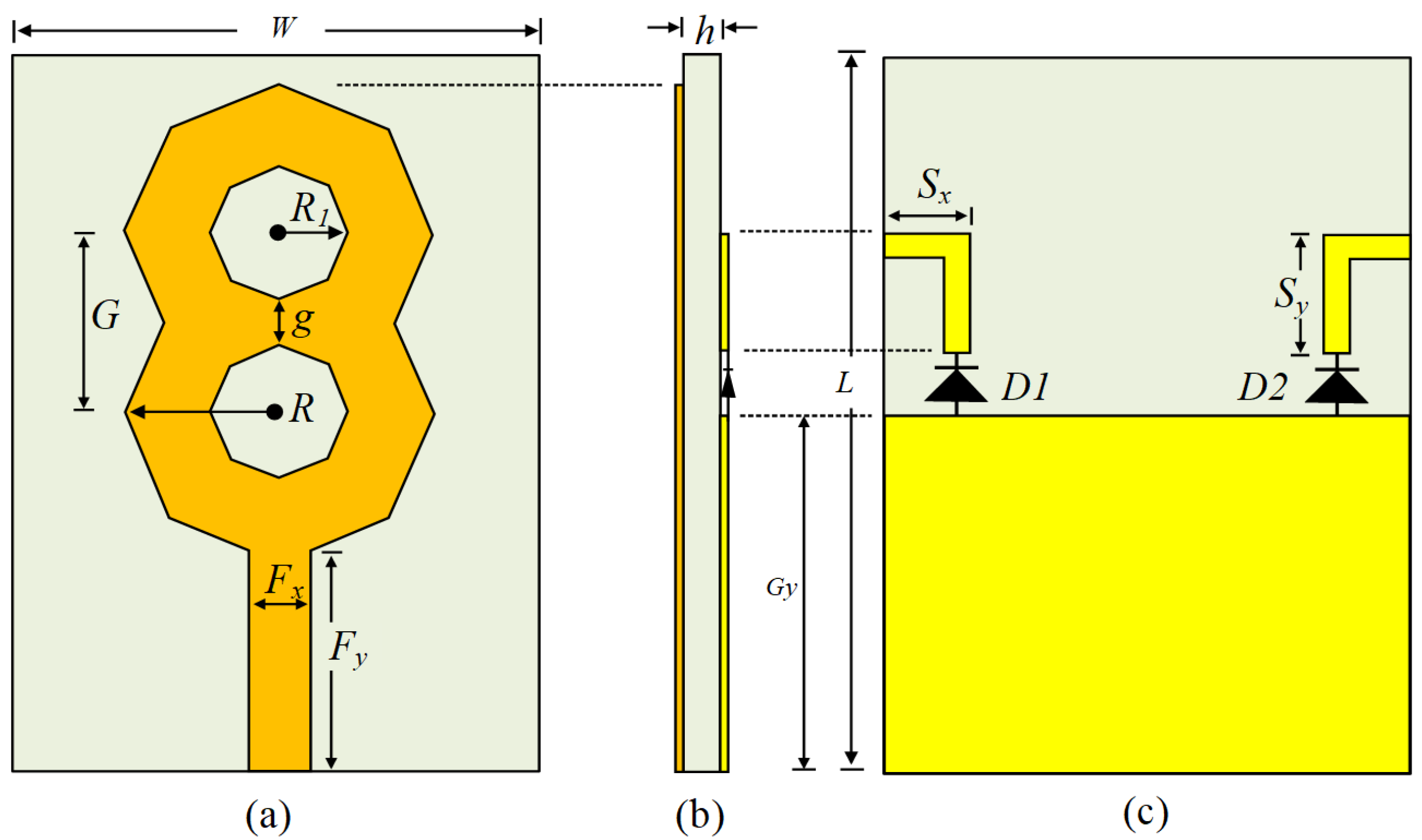
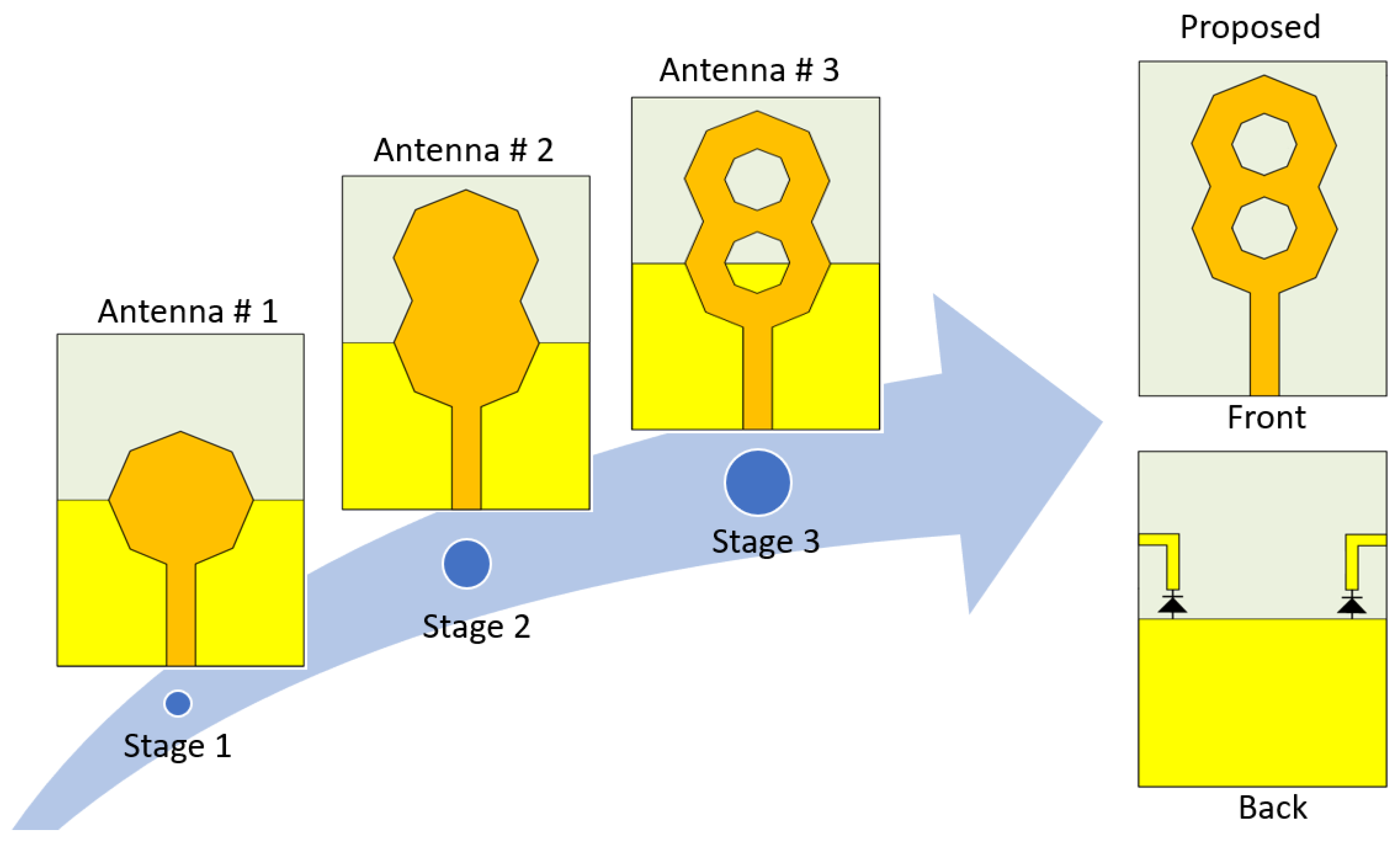
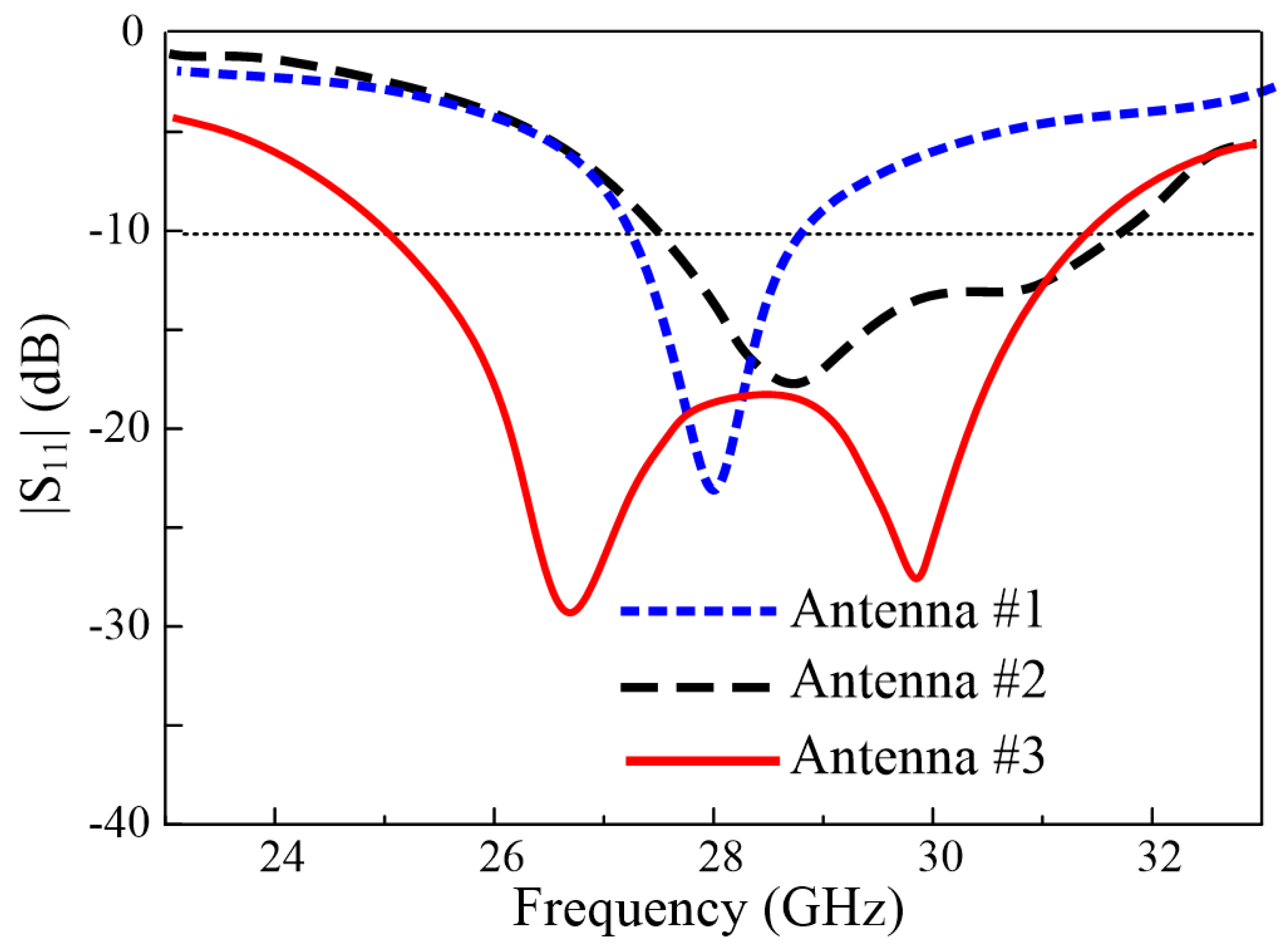
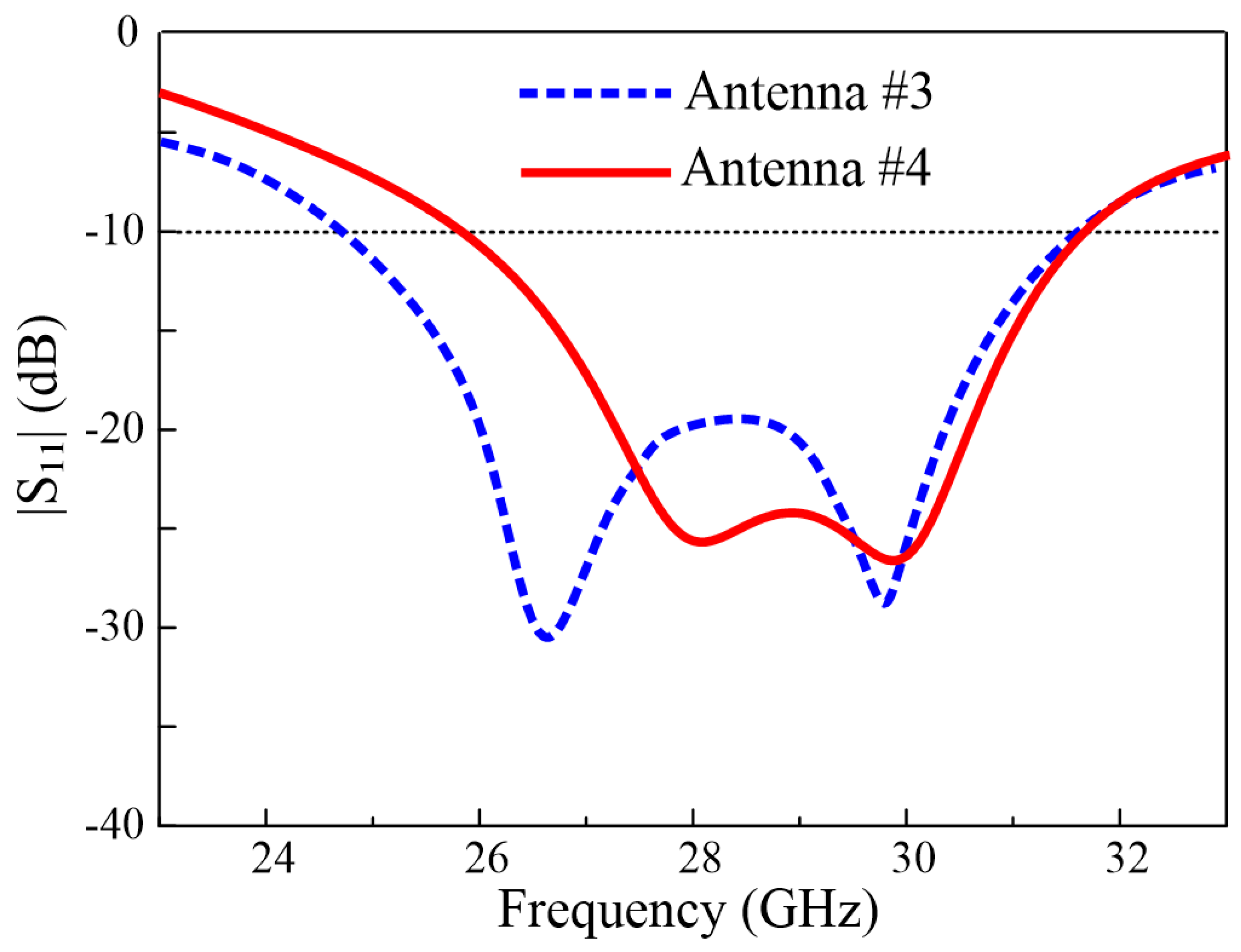


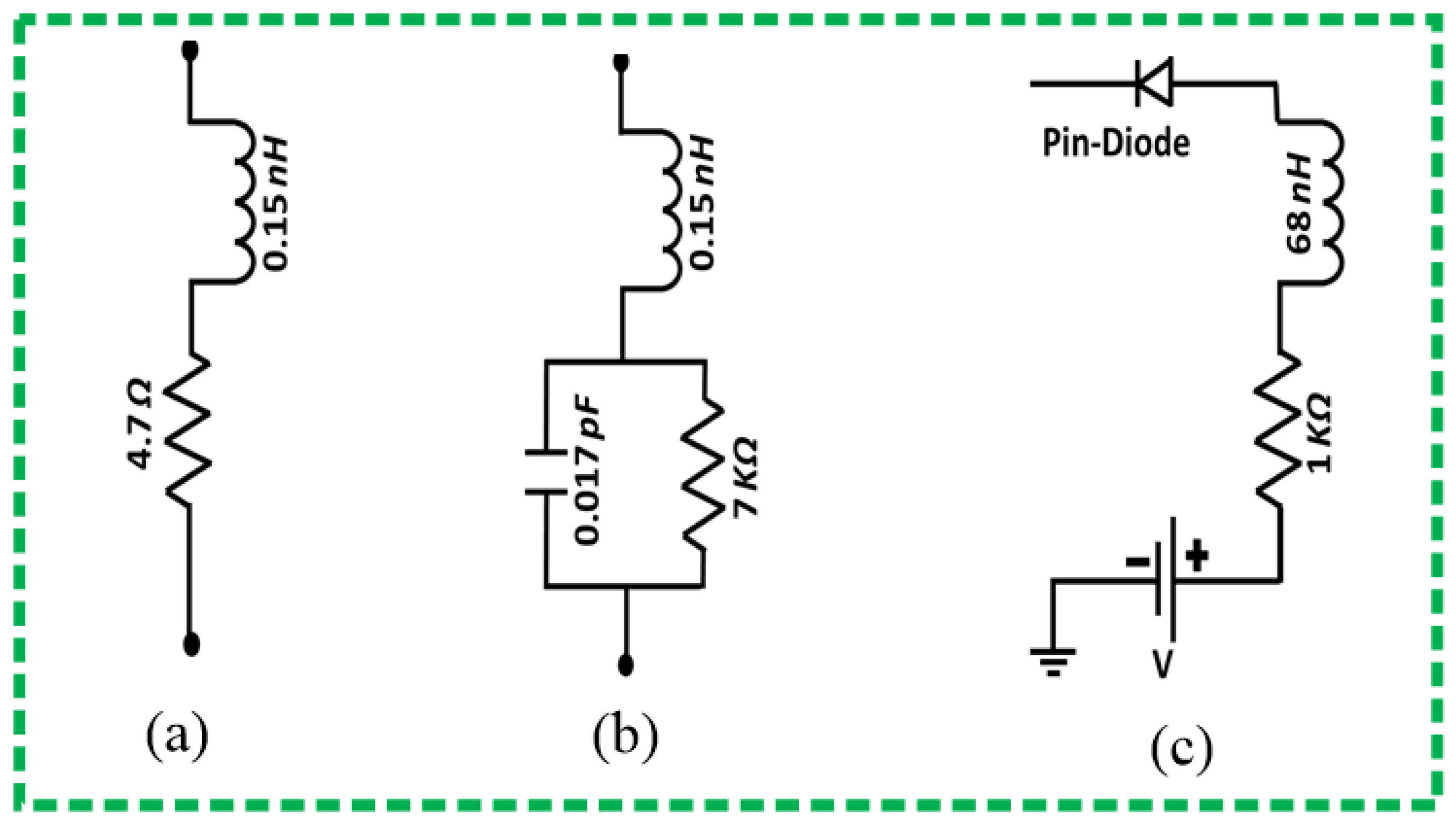

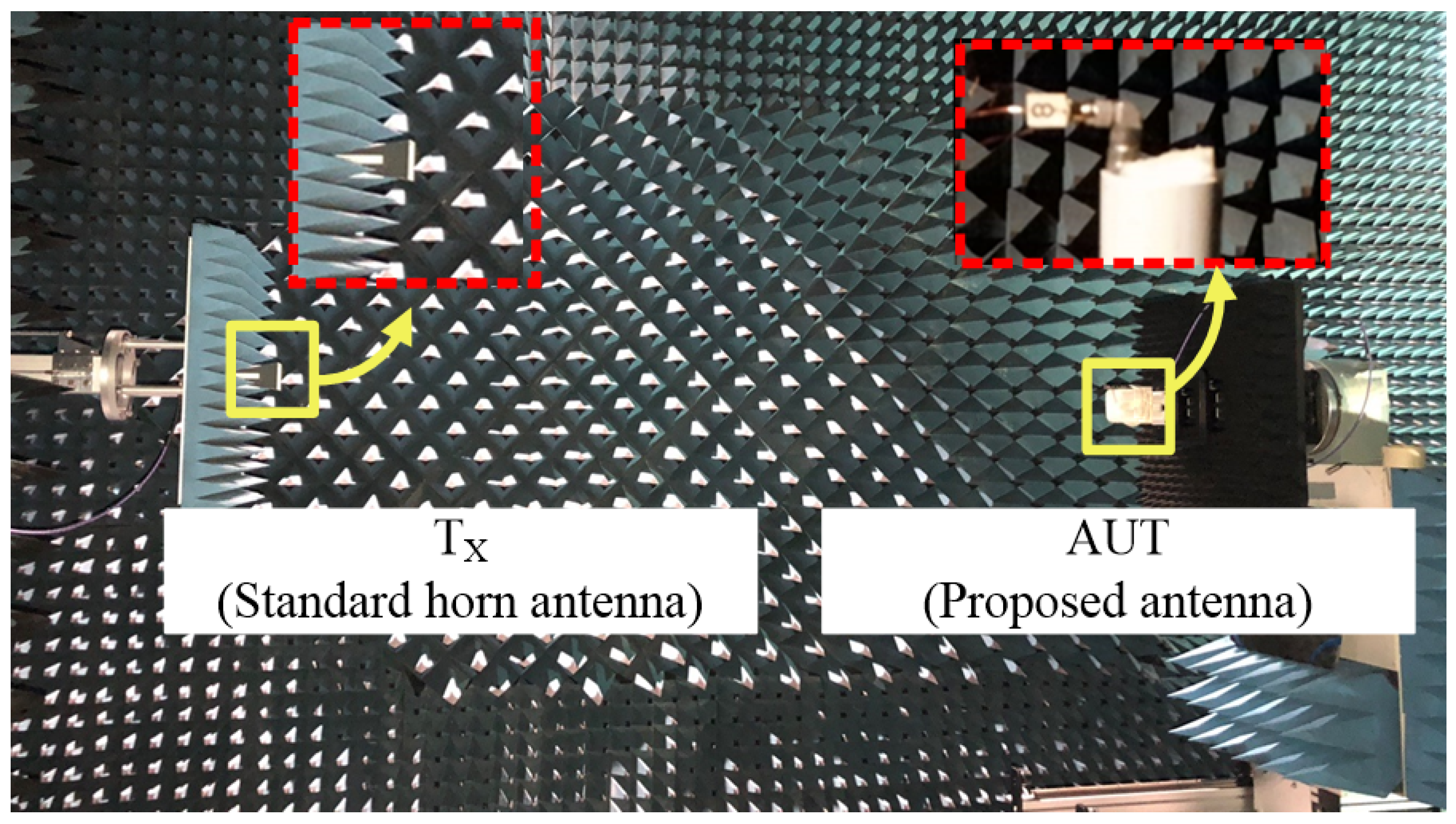

| Parameter | Value (mm) | Parameter | Value (mm) | Parameter | Value (mm) |
|---|---|---|---|---|---|
| L | 12 | R | 1 | F | 1 |
| W | 8.5 | G | 3 | F | 3.7 |
| R | 2.5 | g | 1 | 1.4 | |
| d | 0.4 | G | 6 | 2 |
| Operating Mode | Diode D1 | Diode D2 | Simulated Bandwidth (GHz) | Measured Bandwidth (GHz) | Main Beam Direction (deg) |
|---|---|---|---|---|---|
| I | 0 | 0 | 25.1–31.2 | 25.4–30.8 | 0 |
| II | 0 | 1 | 24.9–31.5 | 26.4–31.4 | −18 |
| III | 1 | 0 | 25.1–31.2 | 26.35–31.4 | +18 |
| Ref. | Dimensions (mm) | Bandwidth (GHz) | Beam-Switching Angles (Theta) | Switching Technique | Peak Gain (dB) |
|---|---|---|---|---|---|
| [17] | 50 × 50 × 6 | 25–30 | 90 and 62 | Mechanical | 9 |
| [18] | 25.9 × 27.8 × 3.5 | 28–31 | 67, 90 and 119 | Mechanical | 9.6 |
| [19] | 17 × 18 × 0.254 | 24.5–31.7 | −25 and 24 | Mechanical | 5.2 |
| [27] | 12 × 16 × 0.254 | 25.8–29.2 | −27 and 30 | Ideal Switches | 6 |
| [28] | 12 × 16 × 0.254 | 25.2–29.7 | −31 and 34 | Ideal Switches | 6.5 |
| Proposed | 8.5 × 12 × 0.508 | 26.4–34.4 | −18, 0 and +18 | PIN diodes | 8.1 |
Publisher’s Note: MDPI stays neutral with regard to jurisdictional claims in published maps and institutional affiliations. |
© 2021 by the authors. Licensee MDPI, Basel, Switzerland. This article is an open access article distributed under the terms and conditions of the Creative Commons Attribution (CC BY) license (https://creativecommons.org/licenses/by/4.0/).
Share and Cite
Zahra, H.; Hussain, M.; Naqvi, S.I.; Abbas, S.M.; Mukhopadhyay, S. A Simple Monopole Antenna with a Switchable Beam for 5G Millimeter-Wave Communication Systems. Electronics 2021, 10, 2870. https://doi.org/10.3390/electronics10222870
Zahra H, Hussain M, Naqvi SI, Abbas SM, Mukhopadhyay S. A Simple Monopole Antenna with a Switchable Beam for 5G Millimeter-Wave Communication Systems. Electronics. 2021; 10(22):2870. https://doi.org/10.3390/electronics10222870
Chicago/Turabian StyleZahra, Hijab, Musa Hussain, Syeda Iffat Naqvi, Syed Muzahir Abbas, and Subhas Mukhopadhyay. 2021. "A Simple Monopole Antenna with a Switchable Beam for 5G Millimeter-Wave Communication Systems" Electronics 10, no. 22: 2870. https://doi.org/10.3390/electronics10222870









